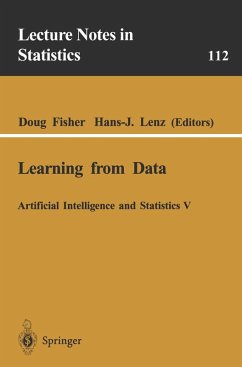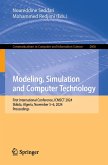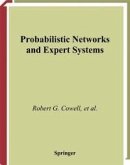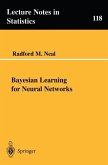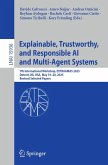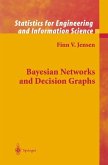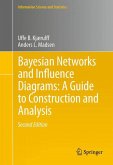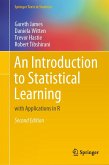Learning from Data (eBook, PDF)
Artificial Intelligence and Statistics V
Redaktion: Fisher, Doug; Lenz, Hans-J.
72,95 €
72,95 €
inkl. MwSt.
Sofort per Download lieferbar

36 °P sammeln
72,95 €
Als Download kaufen

72,95 €
inkl. MwSt.
Sofort per Download lieferbar

36 °P sammeln
Jetzt verschenken
Alle Infos zum eBook verschenken
72,95 €
inkl. MwSt.
Sofort per Download lieferbar
Alle Infos zum eBook verschenken

36 °P sammeln
Learning from Data (eBook, PDF)
Artificial Intelligence and Statistics V
Redaktion: Fisher, Doug; Lenz, Hans-J.
- Format: PDF
- Merkliste
- Auf die Merkliste
- Bewerten Bewerten
- Teilen
- Produkt teilen
- Produkterinnerung
- Produkterinnerung

Bitte loggen Sie sich zunächst in Ihr Kundenkonto ein oder registrieren Sie sich bei
bücher.de, um das eBook-Abo tolino select nutzen zu können.
Hier können Sie sich einloggen
Hier können Sie sich einloggen
Sie sind bereits eingeloggt. Klicken Sie auf 2. tolino select Abo, um fortzufahren.

Bitte loggen Sie sich zunächst in Ihr Kundenkonto ein oder registrieren Sie sich bei bücher.de, um das eBook-Abo tolino select nutzen zu können.
This is fifth in a series of volumes of papers discussing the interactions between artificial intelligence and statistics.
- Geräte: PC
- ohne Kopierschutz
- eBook Hilfe
- Größe: 44.66MB
Andere Kunden interessierten sich auch für
![Modeling, Simulation and Computer Technology (eBook, PDF) Modeling, Simulation and Computer Technology (eBook, PDF)]() Modeling, Simulation and Computer Technology (eBook, PDF)72,95 €
Modeling, Simulation and Computer Technology (eBook, PDF)72,95 €![Probabilistic Networks and Expert Systems (eBook, PDF) Probabilistic Networks and Expert Systems (eBook, PDF)]() Robert G. CowellProbabilistic Networks and Expert Systems (eBook, PDF)88,95 €
Robert G. CowellProbabilistic Networks and Expert Systems (eBook, PDF)88,95 €![Bayesian Learning for Neural Networks (eBook, PDF) Bayesian Learning for Neural Networks (eBook, PDF)]() Radford M. NealBayesian Learning for Neural Networks (eBook, PDF)128,95 €
Radford M. NealBayesian Learning for Neural Networks (eBook, PDF)128,95 €![Explainable, Trustworthy, and Responsible AI and Multi-Agent Systems (eBook, PDF) Explainable, Trustworthy, and Responsible AI and Multi-Agent Systems (eBook, PDF)]() Explainable, Trustworthy, and Responsible AI and Multi-Agent Systems (eBook, PDF)46,95 €
Explainable, Trustworthy, and Responsible AI and Multi-Agent Systems (eBook, PDF)46,95 €![Bayesian Networks and Decision Graphs (eBook, PDF) Bayesian Networks and Decision Graphs (eBook, PDF)]() Thomas Dyhre NielsenBayesian Networks and Decision Graphs (eBook, PDF)64,95 €
Thomas Dyhre NielsenBayesian Networks and Decision Graphs (eBook, PDF)64,95 €![Bayesian Networks and Influence Diagrams: A Guide to Construction and Analysis (eBook, PDF) Bayesian Networks and Influence Diagrams: A Guide to Construction and Analysis (eBook, PDF)]() Uffe B. KjærulffBayesian Networks and Influence Diagrams: A Guide to Construction and Analysis (eBook, PDF)72,95 €
Uffe B. KjærulffBayesian Networks and Influence Diagrams: A Guide to Construction and Analysis (eBook, PDF)72,95 €![An Introduction to Statistical Learning (eBook, PDF) An Introduction to Statistical Learning (eBook, PDF)]() Gareth JamesAn Introduction to Statistical Learning (eBook, PDF)48,95 €
Gareth JamesAn Introduction to Statistical Learning (eBook, PDF)48,95 €-
-
-
This is fifth in a series of volumes of papers discussing the interactions between artificial intelligence and statistics.
Dieser Download kann aus rechtlichen Gründen nur mit Rechnungsadresse in A, B, BG, CY, CZ, D, DK, EW, E, FIN, F, GR, HR, H, IRL, I, LT, L, LR, M, NL, PL, P, R, S, SLO, SK ausgeliefert werden.
Produktdetails
- Produktdetails
- Verlag: Springer US
- Seitenzahl: 450
- Erscheinungstermin: 6. Dezember 2012
- Englisch
- ISBN-13: 9781461224044
- Artikelnr.: 44178959
- Verlag: Springer US
- Seitenzahl: 450
- Erscheinungstermin: 6. Dezember 2012
- Englisch
- ISBN-13: 9781461224044
- Artikelnr.: 44178959
- Herstellerkennzeichnung Die Herstellerinformationen sind derzeit nicht verfügbar.
I Causality.- 1 Two Algorithms for Inducing Structural Equation Models from Data.- 2 Using Causal Knowledge to Learn More Useful Decision Rules from Data.- 3 A Causal Calculus for Statistical Research.- 4 Likelihood-based Causal Inference.- II Inference and Decision Making.- 5 Ploxoma: Testbed for Uncertain Inference.- 6 Solving Influence Diagrams Using Gibbs Sampling.- 7 Modeling and Monitoring Dynamic Systems by Chain Graphs.- 8 Propagation of Gaussian Belief Functions.- 9 On Test Selection Strategies for Belief Networks.- 10 Representing and Solving Asymmetric Decision Problems Using Valuation Networks.- 11 A Hill-Climbing Approach for Optimizing Classification Trees.- III Search Control in Model Hunting.- 12 Learning Bayesian Networks is NP-Complete.- 13 Heuristic Search for Model Structure: The Benefits of Restraining Greed.- 14 Learning Possibilistic Networks from Data.- 15 Detecting Imperfect Patterns in Event Streams Using Local Search.- 16 Structure Learning of Bayesian Networks by Hybrid Genetic Algorithms.- 17 An Axiomatization of Loglinear Models with an Application to the Model-Search Problem.- 18 Detecting Complex Dependencies in Categorical Data.- IV Classification.- 19 A Comparative Evaluation of Sequential Feature Selection Algorithms.- 20 Classification Using Bayes Averaging of Multiple, Relational Rule-Based Models.- 21 Picking the Best Expert from a Sequence.- 22 Hierarchical Clustering of Composite Objects with a Variable Number of Components.- 23 Searching for Dependencies in Bayesian Classifiers.- V General Learning Issues.- 24 Statistical Analysis fo Complex Systems in Biomedicine.- 25 Learning in Hybrid Noise Environments Using Statistical Queries.- 26 On the Statistical Comparison of Inductive Learning Methods.- 27 Dynamical Selection of Learning Algorithms.- 28 Learning Bayesian Networks Using Feature Selection.- 29 Data Representations in Learning.- VI EDA: Tools and Methods.- 30 Rule Induction as Exploratory Data Analysis.- 31 Non-Linear Dimensionality Reduction: A Comparative Performance Analysis.- 32 Omega-Stat: An Environment for Implementing Intelligent Modeling Strategies.- 33 Framework for a Generic Knowledge Discovery Toolkit.- 34 Control Representation in an EDA Assistant.- VII Decision and Regression Tree Induction.- 35 A Further Comparison of Simplification Methods for Decision-Tree Induction.- 36 Robust Linear Discriminant Trees.- 37 Tree Structured Interpretable Regression.- 38 An Exact Probability Metric for Decision Tree Splitting.- VIII Natural Language Processing.- 39 Two Applications of Statistical Modelling to Natural Language Processing.- 40 A Model for Part-of-Speech Prediction.- 41 Viewpoint-Based Measurement of Semantic Similarity Between Words.- 42 Part-of-Speech Tagging from "Small" Data Sets.
I Causality.- 1 Two Algorithms for Inducing Structural Equation Models from Data.- 2 Using Causal Knowledge to Learn More Useful Decision Rules from Data.- 3 A Causal Calculus for Statistical Research.- 4 Likelihood-based Causal Inference.- II Inference and Decision Making.- 5 Ploxoma: Testbed for Uncertain Inference.- 6 Solving Influence Diagrams Using Gibbs Sampling.- 7 Modeling and Monitoring Dynamic Systems by Chain Graphs.- 8 Propagation of Gaussian Belief Functions.- 9 On Test Selection Strategies for Belief Networks.- 10 Representing and Solving Asymmetric Decision Problems Using Valuation Networks.- 11 A Hill-Climbing Approach for Optimizing Classification Trees.- III Search Control in Model Hunting.- 12 Learning Bayesian Networks is NP-Complete.- 13 Heuristic Search for Model Structure: The Benefits of Restraining Greed.- 14 Learning Possibilistic Networks from Data.- 15 Detecting Imperfect Patterns in Event Streams Using Local Search.- 16 Structure Learning of Bayesian Networks by Hybrid Genetic Algorithms.- 17 An Axiomatization of Loglinear Models with an Application to the Model-Search Problem.- 18 Detecting Complex Dependencies in Categorical Data.- IV Classification.- 19 A Comparative Evaluation of Sequential Feature Selection Algorithms.- 20 Classification Using Bayes Averaging of Multiple, Relational Rule-Based Models.- 21 Picking the Best Expert from a Sequence.- 22 Hierarchical Clustering of Composite Objects with a Variable Number of Components.- 23 Searching for Dependencies in Bayesian Classifiers.- V General Learning Issues.- 24 Statistical Analysis fo Complex Systems in Biomedicine.- 25 Learning in Hybrid Noise Environments Using Statistical Queries.- 26 On the Statistical Comparison of Inductive Learning Methods.- 27 Dynamical Selection of Learning Algorithms.- 28 Learning Bayesian Networks Using Feature Selection.- 29 Data Representations in Learning.- VI EDA: Tools and Methods.- 30 Rule Induction as Exploratory Data Analysis.- 31 Non-Linear Dimensionality Reduction: A Comparative Performance Analysis.- 32 Omega-Stat: An Environment for Implementing Intelligent Modeling Strategies.- 33 Framework for a Generic Knowledge Discovery Toolkit.- 34 Control Representation in an EDA Assistant.- VII Decision and Regression Tree Induction.- 35 A Further Comparison of Simplification Methods for Decision-Tree Induction.- 36 Robust Linear Discriminant Trees.- 37 Tree Structured Interpretable Regression.- 38 An Exact Probability Metric for Decision Tree Splitting.- VIII Natural Language Processing.- 39 Two Applications of Statistical Modelling to Natural Language Processing.- 40 A Model for Part-of-Speech Prediction.- 41 Viewpoint-Based Measurement of Semantic Similarity Between Words.- 42 Part-of-Speech Tagging from "Small" Data Sets.
